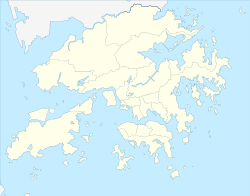The Hong Kong Science Museum is a public science museum in Tsim Sha Tsui East, Kowloon, Hong Kong, located next to the Hong Kong Museum of History.
香港科學館 | |
 Exterior view | |
| Established | 18 April 1991 |
|---|---|
| Location | 2 Science Museum Road Tsim Sha Tsui, Kowloon Hong Kong |
| Coordinates | 22°18′04″N 114°10′39″E / 22.301021°N 114.17751°E |
| Type | Science museum |
| Accreditation | Asia Pacific Network of Science & Technology Centres (ASPAC) |
| Visitors | 1,125,000 (2016)[1] |
| Director | Karen Sit |
| Curator | Paulina Chan Ronne Yuen Kelvin Chung |
| Architect | Palmer and Turner |
| Public transit access | Hung Hom station |
| Website | hk |
| Hong Kong Science Museum | |||||||||||||
|---|---|---|---|---|---|---|---|---|---|---|---|---|---|
| Traditional Chinese | 香港科學館 | ||||||||||||
| Simplified Chinese | 香港科学馆 | ||||||||||||
| |||||||||||||
History
editThe Hong Kong Science Museum was first conceived by the Urban Council in 1976.[2] The council hired American firm E. Verner Johnson and Associates in 1984 to help plan the museum.[3] Three more design firms were later engaged to work on the exhibits: West Office Design, Toshihiko Sakow Associates, and Levy Design.[4] In 1986, the council hired Hong Kong architecture firm Palmer and Turner to design the museum.[3] It was built by Leighton Contractors (Asia) Limited.
Construction began in March 1988 and was completed in November 1990.[3] The museum cost HK$340 million.[2] It was officially opened by Governor David Wilson and Urban Council Chairman H.M.G. Forsgate on 18 April 1991.[2]
In 2000, the Urban Council was disbanded, and management of the museum became the responsibility of the newly formed Leisure and Cultural Services Department.[5]
Exhibits
editThe museum has Cathay Pacific's first DC-3 airliner suspended from the ceiling.
The most popular exhibition items for children are a computer area, a real (but stationary) car in which visitors can attempt to drive in a driving simulation while avoiding accidents, speeding, and excessive fuel usage, and a small life-sized stationary aircraft with a video of a flight around Hong Kong playing inside the cockpit. Refreshments are provided at a small cafe.
About 500 exhibits are displayed in the permanent exhibition area. The most prominent exhibit is the 22-metre-high twin-tower Energy Machine which is the largest of its kind in the world. A total of 18 galleries cover a wide range of science and technology topics including light, sound, motion, electricity and magnetism, mathematics, life science, geography, meteorology, computer, transportation, communication, food science, energy/energy conservation and home technology. About 80 per cent of the exhibits are participatory so that visitors may learn through direct involvement.
The museum staff also performs live demonstrations daily, many of which are designed for younger visitors.
Transportation
editThe museum is within walking distance of Hung Hom station of the Mass Transit Railway (MTR).
Future
editIn late 2023, the Hong Kong government proposed to move the science museum to Sha Tin and use the site in Tsim Sha Tsui for a new museum that will promote the "development and achievements of China". The Culture, Sports and Tourism Bureau proposed that the new museum would improve teenagers' understanding of China by showcasing Chinese history, the Chinese Communist Party, "the establishment of the new China", Chinese economic reform, and national achievements.[6]
See also
editReferences
edit- ^ "Statistics Report". Leisure and Cultural Services Department. Retrieved 25 June 2017.
- ^ a b c Green, Lisa (19 April 1991). "Governor opens Science Museum". South China Morning Post. p. 3.
- ^ a b c "Developing new place of wonder". South China Morning Post. 19 April 1991. p. 59.
- ^ Serjeant, John (19 April 1991). "Discoveries in a hi-tech wonderland". South China Morning Post. p. 57.
- ^ "Our History". Hong Kong Science Museum. Retrieved 25 June 2017.
- ^ "Hong Kong plans to replace science museum with new one focusing on national development". The Standard. 6 December 2023.
